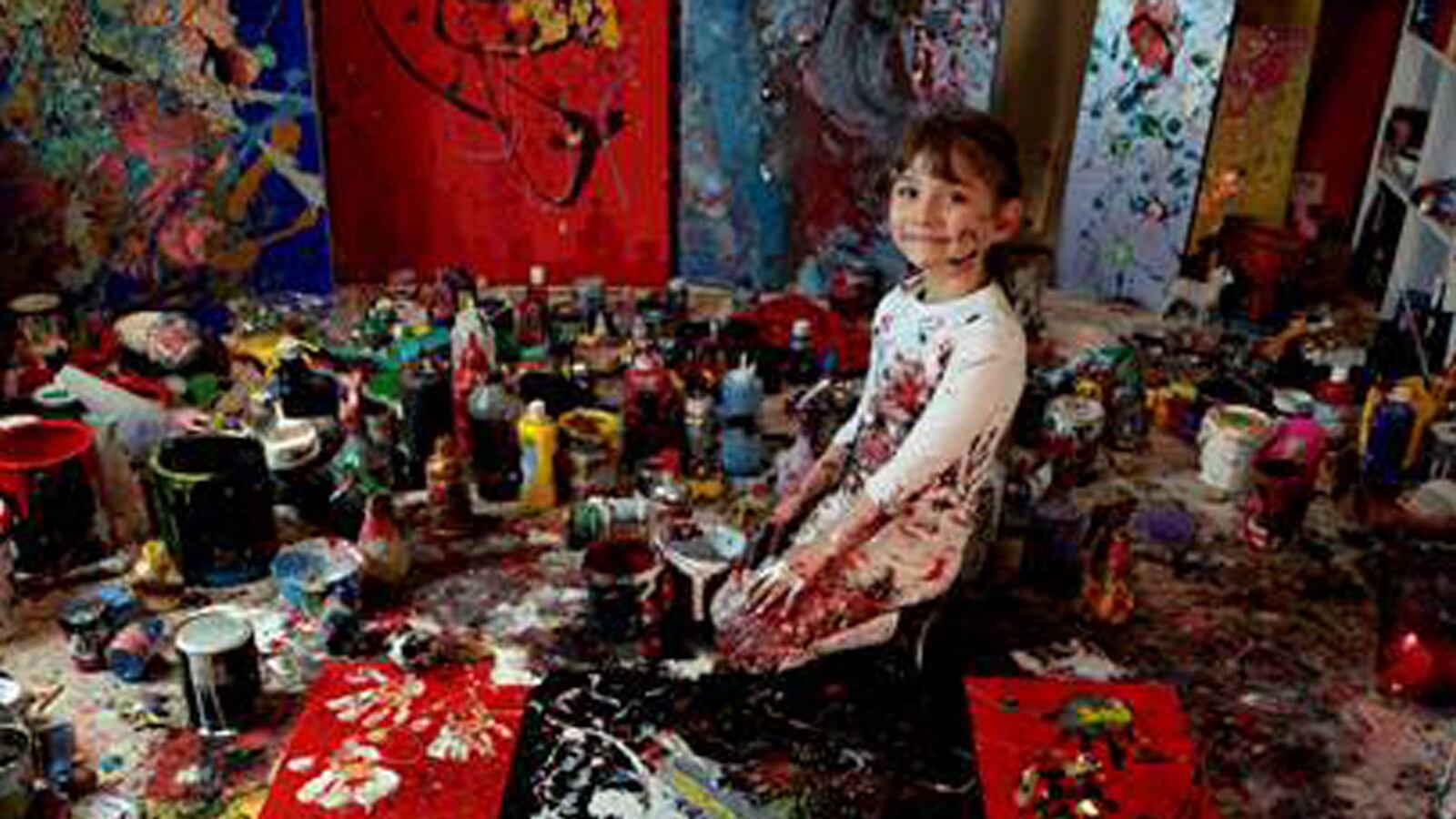At all of seven years old, Aelita Andre has already held the title of “child prodigy” for five years. She became an international sensation at the tender age of two—before she even started pre-school—for her abstract works of art. The New York Times, 60 Minutes, and Time are just a few of the global media outlets that picked up her story, painting her as a “pee-wee Picasso” and leaving the tot with a life-long reputation for talent to uphold.
The discovery of Andre’s gift all happened by chance, her mother, Nikka Kalashnikova, told me at a reception for one of her most recent exhibitions, Aelita Andre—The Oracle of Space, which was on display at Gallery 151 in New York City. Some nine months after being born, Aelita, dressed in diapers, crawled across her father’s canvas, picked up tubes of pigment and started to spread and mix the colors, not realizing this was the start of her artistic career. “She really just took over,” Kalashnikova said of Andre’s ambition to paint. “It’s all very natural for her. It’s so amazing that someone her age really knows what they want to do in life.”
Kalashnikova and her husband, Michael Andre, are both artists, so creative blood runs in the family. “We do a little bit of painting and photography, and we are both film makers,” she said. When the couple noticed their daughter’s eye for color and composition, they soon sent samples to New York’s Agora Gallery, deliberately withholding Aelita’s age to ensure a proper reaction. The results led to their daughter’s first show.
“I saw great colors, great movement, great composition, and very playful, and I thought, ‘This is fantastic,’” Angela Di Bellow, director of Agora Gallery told NBC of her reaction seeing the work for the first time. “Who is this person? Only to find out, she’s a child.”
Di Bello described the color-splashed works as “abstract expressionism” with “surrealist” methods. Aelita incorporates both pigment and everyday objects such as toys, instruments, and textiles, lending depth and texture to the flat surfaces, much like lauded artists before her.
But, it’s hard to not be skeptical. Can a seven year old—let alone a two year old—really make the conscious calculations necessary to create “true” works of art? Or do her parents—who are also artists—play a large role in guiding the brush that pulled in well over $200,000 in 2012?
This has been the biggest question Aelita and her family have faced.
“I really enjoy painting,” Aelita told The Daily Beast. “I just like that I get to express my freedom.”
This freedom was thoroughly expressed at her gallery reception. Aelita spent the majority of her time oscillating between camera interviews, where she was perfectly poised, and running around (and in between guests) playing hide-and-seek from flashbulb photographers, occasionally screaming at the top of her lungs. At no moment was she unprofessional during interviews, but as soon as the questions stopped, she went back to being a playful 7-year-old.
In 2009, during her first exhibition, Reuters spoke with art critics who had a high amount of skepticism that Aelita’s work was 100-percent original. “There’s probably some degree of collaboration between parent and child,” art critic and professor of art and design Robert Nelson, said. “The colorful backdrop, the calligraphic marks that was probably put there by a parent, that’s not the work of a child, certainly not a child of that age.” Aelita was two.
Her parents rebutted the accusations through homemade (though highly produced) videos which promote her exhibitions. In the video that accompanied a 2012 show at Chelsea’s Agora Gallery, Aelita stands in her studio splattering paint wildly onto a canvas with a pensive look—much like one would imagine Jackson Pollock, but without the martini.
Her recent exhibition—and fourth New York solo show—at Gallery 151 brought about a “groundbreaking new series of works fusing painting with sound,” according to Gallery 151’s website. Aelita, who has mounted violins onto her canvases, physically plays her art, merging painting and performance while encouraging spectators to touch and interact with the works.
“Once the violin is totally onto the canvas with the paint and glitter and things, they are a part of each other,” Aelita told The Daily Beast. “You can’t separate them. The same way my art is a part of me; the violin is a part of the canvas and the painting is able to sing.” The sounds she performs from the violins on canvas replicate her idea of sounds found in the cosmos. The inspiration was garnered from a recent fascination with space documentaries and Neil Degrasse Tyson, whom she was hoping would stop by the reception.
Each work incorporates an interest in space and the cosmos—stars, planets, galaxies, and even human existence. Dinosaurs are strategically placed in migration across a three-panel oil piece, gradually making their way away from a massive explosion of color. Her very first sculpture, a metallic chrome unicorn aptly titled “Space Oracle,” sits on a pedestal directly in front. It serves as the heart of the collective works, as an interface between the cosmos and humanity.
Whether or not Aelita realizes the scrutiny she’s been under, she has undoubtedly undergone a big transformation—which is expected of someone learning to walk, talk, and develop original interests and ideas. The two-year-old, “My-Child-Could-Do-That-Too” sensation who once hit tubes of paint against a canvas until the pigment ran out has evolved into a methodized (and knowledgeable) artist in her own right.






